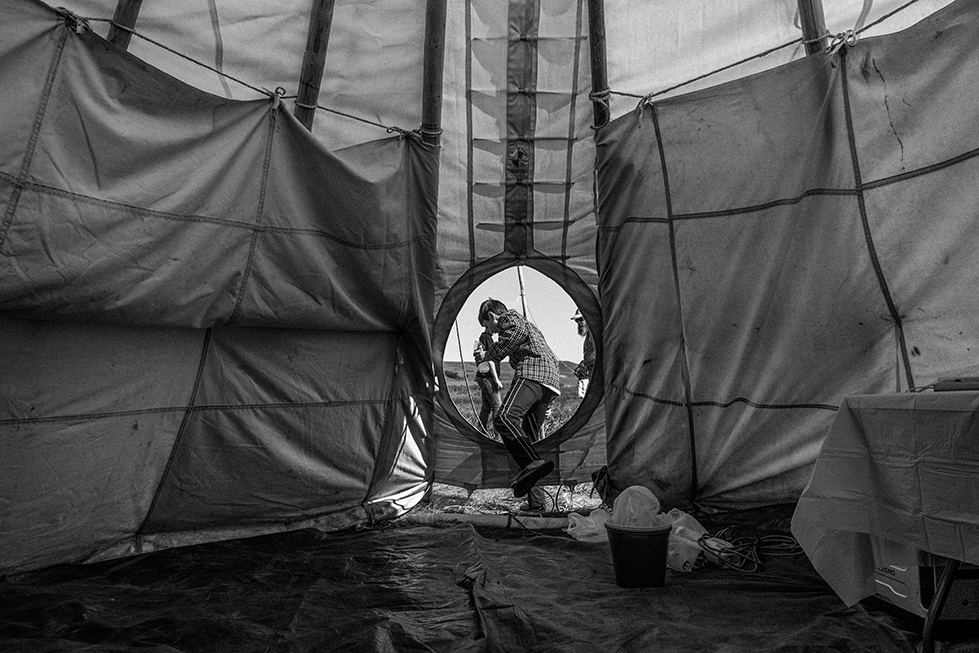In Photos: Water Protectors Return to Standing Rock—This Time for Healing
The camps are gone now, but the awakening to protect the water, land, and tribal sovereignty continues.
By Josué Rivas
YES! Magazine
yesmagazine.org
It’s been about a year since thousands of people were arriving each day from all over the world to join the Lakota, Nakota, and Dakota nations on the Dakota plains to protect the Missouri River. The camps are gone now, but the awakening to protect the water, land, and tribal sovereignty continues in Oceti Sakowin territory.
But first, people had to heal.
Last month, I joined the Mní Wičoni Healing Gathering near Porcupine Creek at Standing Rock. The water protectors returned. Those who had spent time over the past year in this place creating community, praying, and standing strong traveled from distant places to once again pray, laugh, and heal.
I personally was in need of this medicine and was grateful. For over half a year, I documented the opposition to the Dakota Access pipeline and wanted to see how other folks were doing. This time around, the energy was reflective. It felt like the end of a chapter, and a transition to new front lines. The fire at Oceti Sakowin taught us that, in fact, we carry its flame within us and that there is no turning back.
 CEREMONY: When you arrived at Oceti Sakowin, security at the gate would say, “Welcome home.” In this way, every person that entered camp was entering their own ceremony. Some came for a couple of days or stayed for months. Some never left. The ground and the sky there were home to their prayers. Ancestral and modern. And just like that, some warriors were born. Photo by Josué Rivas
CEREMONY: When you arrived at Oceti Sakowin, security at the gate would say, “Welcome home.” In this way, every person that entered camp was entering their own ceremony. Some came for a couple of days or stayed for months. Some never left. The ground and the sky there were home to their prayers. Ancestral and modern. And just like that, some warriors were born. Photo by Josué Rivas
 MNÍ WIČONI: Elders said that in order to be one with everything, one must be willing to make a sacrifice: flesh, fasting, or light. Without water, there is no life. The seeds we offer now will grow in seven generations. What if we could heal with clean water and restore our natural ways of life? These are the questions I don’t want our grandchildren to have to ask when the Earth is dry. Photo by Josué Rivas
MNÍ WIČONI: Elders said that in order to be one with everything, one must be willing to make a sacrifice: flesh, fasting, or light. Without water, there is no life. The seeds we offer now will grow in seven generations. What if we could heal with clean water and restore our natural ways of life? These are the questions I don’t want our grandchildren to have to ask when the Earth is dry. Photo by Josué Rivas
 1492: The day we die, we take nothing with us. No home, no money, no car. We will leave this existence free. But in the meantime, we must fight with our prayer, our voices, and our bodies. Photo by Josué Rivas
1492: The day we die, we take nothing with us. No home, no money, no car. We will leave this existence free. But in the meantime, we must fight with our prayer, our voices, and our bodies. Photo by Josué Rivas
 OYATE: The people. A nation. These concepts come in many forms. Ourselves, our family, and our community. The inner circles are the priority, and that’s where true power comes from. Photo by Josué Rivas
OYATE: The people. A nation. These concepts come in many forms. Ourselves, our family, and our community. The inner circles are the priority, and that’s where true power comes from. Photo by Josué Rivas
 HEALING: So many people speak about the American Dream, but they forgot about the American Holocaust. Photo by Josué Rivas
HEALING: So many people speak about the American Dream, but they forgot about the American Holocaust. Photo by Josué Rivas
 MEDICINE: We are giving birth to the next seven generations. Photo by Josué Rivas
MEDICINE: We are giving birth to the next seven generations. Photo by Josué Rivas
 MEDITATION: The fire doesn’t speak English, Spanish, or French. The fire speaks a language older than our understanding, and in order for us to communicate, we must humble ourselves. The fire never ends because it is lit inside our hearts. Together we are standing strong. Photo by Josué Rivas
MEDITATION: The fire doesn’t speak English, Spanish, or French. The fire speaks a language older than our understanding, and in order for us to communicate, we must humble ourselves. The fire never ends because it is lit inside our hearts. Together we are standing strong. Photo by Josué Rivas
This article was funded in part by a grant from the Surdna Foundation and the NoVo Foundation.
Josué Rivas (Mexica/Otomi) is an award-winning indigenous documentary photographer, cinematographer, and film director specialized in working on stories that challenge the mainstream narrative about indigenous people. He is the founder of the Standing Strong Project which is made possible in part by the 2017 Magnum Foundation Photography and Social Justice Fellowship.
Note: This article originally appeared on
YES!
Magazine. It is published under a
Creative
Commons license.
Join the Conversation








